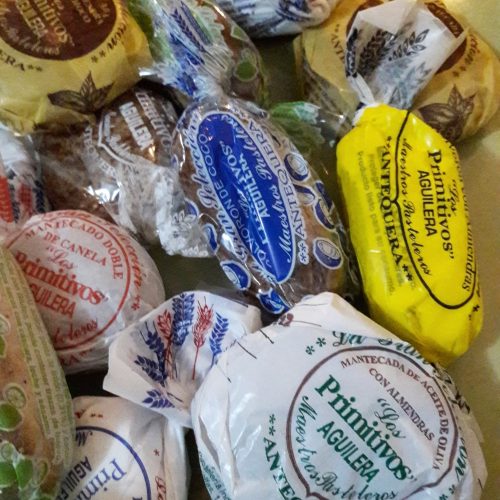
Traditions: Mantecados and Polvorones (Spanish Christmas Sweets)
 Mantecados and Polvorones
Mantecados and Polvorones
One of the most enjoyable parts of being in a new country at the holidays in taking in some of their traditions and where better to start than with the food! At Christmas time, there are lots of great treats to be found. Spaniards love Christmas sweets and so there are many to choose from, but the most typical across the country, at least in our experience, are the mantecados and polvorones.
History
These sweets are made in Andalucía, though now distributed throughout the country. The orignal recipe was brought to Spain by the Moors and they’re actually quite simple. The main ingredients in both mantecados and polvorones are pork fat, flour, and sugar. The use of pork fat was required during the Inquisitions as the leaders of the Inquisition wanted to use it as a means of uncovering any secret Muslims or Jews. Nowadays, other alternatives—especially olive oil—are available as well. Still, you can’t get away from the fact that their name comes from manteca, or lard.
 Well, what are they?
Well, what are they?
Despite sounding gross from the last paragraph of explanation, we promise you these are really tasty treats and probably unlike anything you have had before! They also come in an assortment of flavors, including but not limited to almond, coconut, cinnamon, lemon, and chocolate. Although Wikipedia’s English version chooses to classify mantecados and polvorones as shortbread, that translation doesn’t do the Spanish sweet justice.
The solid texture of these ‘cookies’ is utterly fragile, crumbling into a dusty mess at the wrong touch of a finger (makes sense, as the polvo in polvorones translates to dust)*. Handled delicately, however, they maintain intact and have a sweet, almost heavy taste. It’s strange and hard to explain…you simply have to try them yourself.
 So what’s the difference?
So what’s the difference?
This question has been haunting us since we discovered these Christmas sweets (which are becoming more and more available year-round). In a recently chat with the saleswomen who works at our local Delicias de Navidad**, she surprised us by confirming our suspicions that they’re basically the same, just different shapes. In digging a bit more on the internet, we’ve discovered a few more details.
It basically comes down to a rectangle-and-square situation. You remember those geometry days, right? How all squares are rectangles, but not all rectangles are squares? Well mantecados are rectangles and polvorones are squares. Basically, you would be correct in simply grouping them altogether as mantecados because they share that same basic recipe. However, once almonds are added to the mix—either literally in the dough or crumpled on top—and the flour is toasted, the mantecados are also considered polvorones. Traditionally, polvorones are covered in a powdered sugar layer as well but this is not required. If none of that really matters to you, the difference that you’ll see on the shelves is that mantecados are round in shape whereas polvorones tend to be oblong ovals.
 So there you have it, a quick guide to mantecados and polvorones. You’ll now know way more than we did when we started enjoying these ‘Christmas delicacies.’ So what do you think, will you give them a taste test? What about sending some home to Mom and Dad? Let us know about your experiences!
So there you have it, a quick guide to mantecados and polvorones. You’ll now know way more than we did when we started enjoying these ‘Christmas delicacies.’ So what do you think, will you give them a taste test? What about sending some home to Mom and Dad? Let us know about your experiences!
Sincerely,
Spain
*We recently discovered that some people like to avoid this hazard by squishing down their mantecado while it’s still in the packaging. This way, the dusty consistency becomes more compact. We don’t use this method personally, but it sure seems like it’d be effective.
**This is a shop that pops up here in Granada for just two months a year to supply the high demand for these treats at Christmas time.




